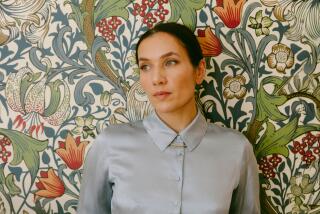Are ladies of literature secret clotheshorses?
- Share via
Some of the most dynamic female writers today are turning their attention to clothes. Is it the secret influence of Fashion Week? Have clothes been on their minds all along?
Man Booker Prize winner Margaret Atwood talked about the importance of clothes in her novel “The Blind Assassin” on the Guardian Books Blog’s podcast. Atwood declared her interest in the “neglected study” of clothing technologies, particularly when it comes to military uniforms. She gives the example of the nylon uniforms issued to American soldiers fighting in the Korean War -- the material “when you walk goes poosh, poosh, poosh. It made people very audible. Bad clothing to have for a war that was fought a lot in the dark by guerrillas.”
In Sheila Heti’s “How Should A Person Be?” a yellow dress balloons into conflict between the two main characters; the intimate nature of clothing can reveal something to readers about characters, and their circumstances. Now Heti, along with novelist Heidi Julavits and writer and artist Leanne Shapton (“Swimming Studies”), are editing the anthology “Women in Clothes,” to be released next fall. It will feature essays on getting dressed from Miranda July, Zadie Smith and other writers. Beginning next spring, the project will also host an online forum for readers to engage each other with the ideas that the book will explore.
In an interview about “Women in Clothes” with W magazine, Heti draws a link between literature, the stories that unfold on the page and in the mind of a reader, and clothing: “It’s not terribly useful to see outfits. I think it’s much more useful to see thinking.”
Our choice of clothing tells a story about who we are and how we think, and the same goes for fictional characters. In the same interview, Julavits says that the impulse for the project came out of her sense of the importance of clothing as a tool for novelists to show something about their characters. She adds, “I read humans, and in particular women, through the clothing they put on their bodies. I understood their outfits as public witnesses to their more secret selves.”
Inspired by Atwood’s ideas, the Guardian is asking readers to share their thoughts on clothing in literature. For my part, I can’t separate Emma Bovary from one of the first times her future husband Charles sees her, with her leather booties peeking out of her clacking wooden garden shoes.
ALSO:
New National Book Award procedures include surprises
Two 19th century Gothic classics get Goth YA makeovers
People often lie about reading classic novels, survey finds
More to Read
Sign up for our Book Club newsletter
Get the latest news, events and more from the Los Angeles Times Book Club, and help us get L.A. reading and talking.
You may occasionally receive promotional content from the Los Angeles Times.






